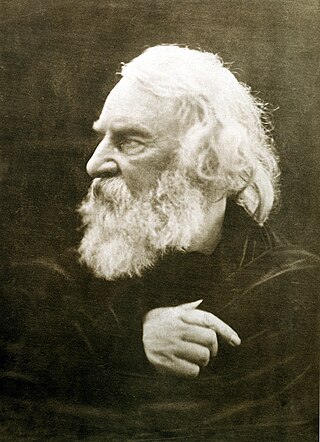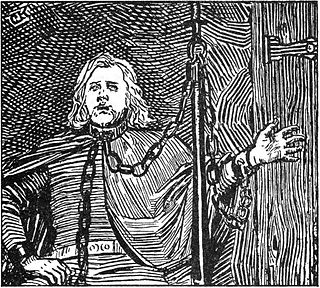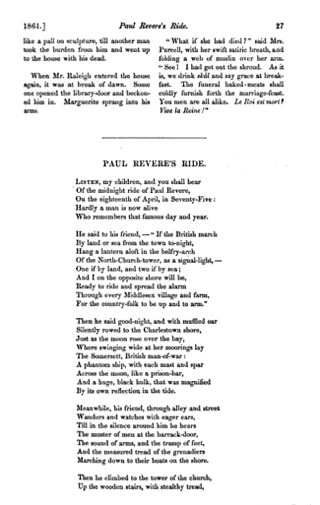
In Norse mythology, Brísingamen is the torc or necklace of the goddess Freyja. The name is an Old Norse compound brísinga-men whose second element is men "(ornamental) neck-ring, torc". The etymology of the first element is uncertain. It has been derived from Old Norse brísingr, a poetic term for "fire" or "amber" mentioned in the anonymous versified word-lists (þulur) appended to many manuscripts of the Prose Edda, making Brísingamen "gleaming torc", "sunny torc", or the like. However, Brísingr can also be an ethnonym, in which case Brísinga men is "torque of the Brísings"; the Old English parallel in Beowulf supports this derivation, though who the Brísings may have been remains unknown.

Henry Wadsworth Longfellow was an American poet and educator. His original works include the poems "Paul Revere's Ride", "The Song of Hiawatha", and "Evangeline". He was the first American to completely translate Dante Alighieri's Divine Comedy and was one of the fireside poets from New England.

Olaf Tryggvason was King of Norway from 995 to 1000. He was the son of Tryggvi Olafsson, king of Viken, and, according to later sagas, the great-grandson of Harald Fairhair, first King of Norway. He is numbered as Olaf I.

A skald, or skáld is one of the often named poets who composed skaldic poetry, one of the two kinds of Old Norse poetry in alliterative verse, the other being Eddic poetry. Skaldic poems were traditionally composed to honor kings, but were sometimes extempore. They include both extended works and single verses (lausavísur). They are characteristically more ornate in form and diction than eddic poems, employing many kennings, which require some knowledge of Norse mythology, and heiti, which are formal nouns used in place of more prosaic synonyms. Dróttkvætt metre is a type of skaldic verse form that most often use internal rhyme and alliteration.

Thor is a prominent god in Germanic paganism. In Norse mythology, he is a hammer-wielding god associated with lightning, thunder, storms, sacred groves and trees, strength, the protection of humankind, hallowing, and fertility. Besides Old Norse Þórr, the deity occurs in Old English as Þunor ("Thunor"), in Old Frisian as Thuner, in Old Saxon as Thunar, and in Old High German as Donar, all ultimately stemming from the Proto-Germanic theonym *Þun(a)raz, meaning 'Thunder'.

The Battle of Svolder was a large naval battle during the Viking age, fought in September 999 or 1000 in the western Baltic Sea between King Olaf of Norway and an alliance of the Kings of Denmark and Sweden and Olaf's enemies in Norway. The backdrop of the battle was the unification of Norway into a single independent state after longstanding Danish efforts to control the country, combined with the spread of Christianity in Scandinavia.

Dudley Buck was an American composer, organist, and writer on music. He published several books, most notably the Dictionary of Musical Terms and Influence of the Organ in History, which was published in New York City in 1882.

Sigvatr Þórðarson or Sighvatr Þórðarson or Sigvat the Skald (995–1045) was an Icelandic skald. He was a court poet to King Olaf II of Norway, as well as Canute the Great, Magnus the Good and Anund Jacob, by whose reigns his floruit can be dated to the earlier eleventh century. Sigvatr was the best known of the court skalds of King Olaf and also served as his marshal (stallare), even baptizing his son Magnus.

Tales of a Wayside Inn is a collection of poems by American poet Henry Wadsworth Longfellow. The book, published in 1863, depicts a group of people at the Wayside Inn in Sudbury, Massachusetts, as each tells a story in the form of a poem. The characters telling the stories at the inn are based on real people. The compilation, which Longfellow originally wanted to title "The Sudbury Tales", proved to be popular and he issued two additional series in the 1870s.
Óláfs saga Tryggvasonar is the name of several kings' sagas on the life of Óláfr Tryggvason, a 10th-century Norwegian king.
Steinunn Refsdóttir was an Icelandic skald active at the end of the 10th century. Two verses by her are preserved, in which she taunts the missionary Þangbrandr.

"The Children's Hour" is a poem by American poet Henry Wadsworth Longfellow, first published in the September 1860 edition of The Atlantic Monthly.

Death in Norse paganism was associated with diverse customs and beliefs that varied with time, location and social group, and did not form a structured, uniform system. After the funeral, the individual could go to a range of afterlives including Valhalla, Hel and living on physically in the landscape. These afterlives show blurred boundaries and exist alongside a number of minor afterlives that may have been significant in Nordic paganism. The dead were also seen as being able to bestow land fertility, often in return for votive offerings, and knowledge, either willingly or after coercion. Many of these beliefs and practices continued in altered forms after the Christianisation of the Germanic peoples in folk belief.

"A Psalm of Life" is a poem written by American writer Henry Wadsworth Longfellow, often subtitled "What the Heart of the Young Man Said to the Psalmist". Longfellow wrote the poem not long after the death of his first wife and while thinking about how to make the best of life. It was first published anonymously in 1838 before being included in a collection of Longfellow's poems the next year. Its inspirational message has made it one of Longfellow's most famous poems.

"Paul Revere's Ride" is an 1860 poem by American poet Henry Wadsworth Longfellow that commemorates the actions of American patriot Paul Revere on April 18, 1775, although with significant inaccuracies. It was first published in the January 1861 issue of The Atlantic Monthly. It was later retitled "The Landlord's Tale" in Longfellow's 1863 collection Tales of a Wayside Inn.
Raud the Strong was a Norse chieftain, blót practitioner and seafaring warrior, who resisted conversion to Christianity in the late 10th century AD, described in Heimskringla.
King Olaf, King Olav, or similar, may refer to:

Henry Wadsworth Longfellow is a bronze statue, by William Couper, and Thomas Ball. The statue depicts American poet Henry Wadsworth Longfellow. It is located at the intersection of M Street and Connecticut Avenue, N.W. Washington, D.C., and was dedicated on May 7, 1909.
Surviving texts indicate that there was a belief in rebirth in Germanic paganism. Examples occur in eddic poetry and sagas, potentially associated with naming and/or through the family line. Scholars have discussed the implications of these attestations and proposed theories regarding belief in reincarnation among the Germanic peoples prior to Christianization and potentially to some extent in folk belief thereafter.

The Wayside Inn is a historic inn in Sudbury, Massachusetts, United States. The inn is included on the National Register of Historic Places as part of the listed Wayside Inn Historic District. It became an inn, called Howe's Tavern, in 1716, making it the oldest continuously operating inn in the United States. The Beekman Arms Inn and others make various claims towards being "continuously operating", resulting from The Wayside Inn's closure period of 1861–1897, after the death of Lyman Howe.















